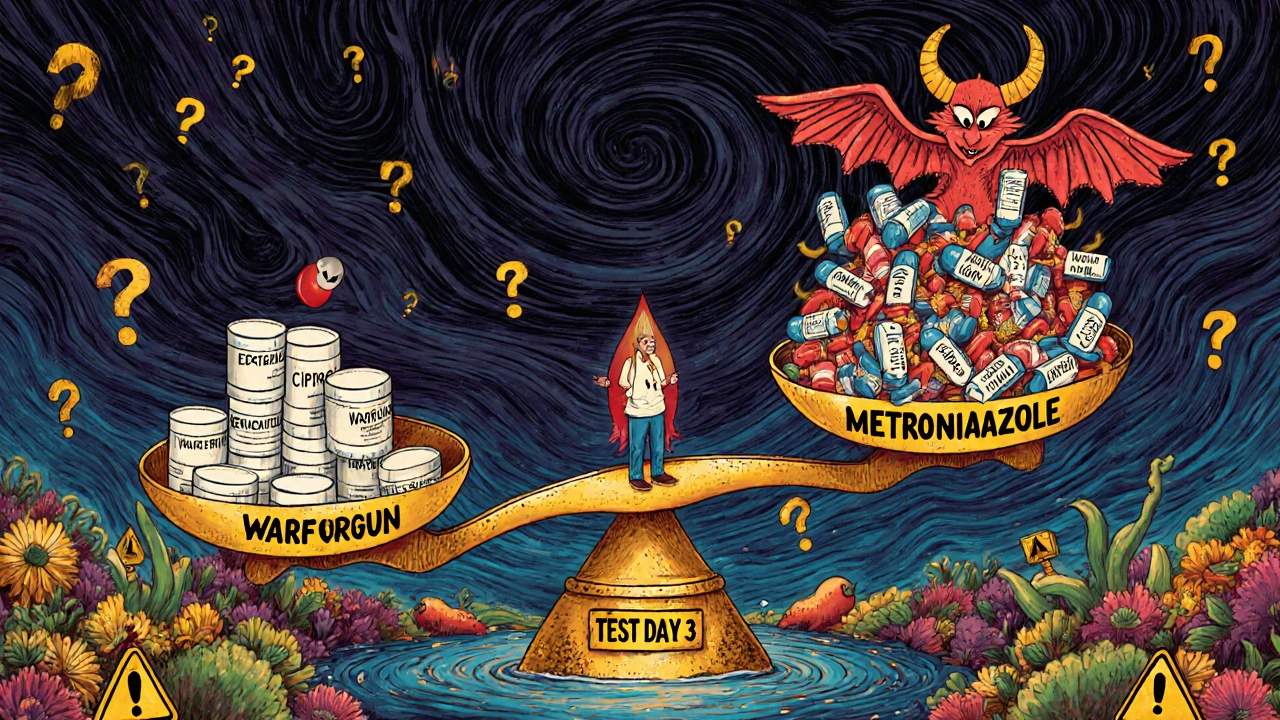INR Antibiotic Risk Calculator
Antibiotic Selection
Risk Assessment
Recommendations
When you're on warfarin, even a simple course of antibiotics can turn dangerous-without you realizing it. Your INR, a number that tells doctors how long it takes your blood to clot, can jump from a safe 2.5 to a life-threatening 8.0 in just a few days. This isn't rare. It happens to thousands of people every year, often because no one warned them that the antibiotic for a sinus infection could be as risky as skipping a warfarin dose.
Why Warfarin Is So Sensitive
Warfarin works by blocking vitamin K, which your body needs to make clotting factors. It’s old, cheap, and effective-but it has almost no room for error. The difference between a dose that prevents clots and one that causes bleeding is tiny. That’s why your INR must stay between 2.0 and 3.0 for most people. Above 5.0? Your risk of internal bleeding spikes dramatically.
What makes warfarin so unpredictable is how your body breaks it down. It relies on liver enzymes-mainly CYP2C9-that can be slowed down or sped up by other drugs. Antibiotics don’t just kill bacteria. They also mess with your gut bacteria, which normally make about 10-15% of your daily vitamin K. Less vitamin K means warfarin works harder. That’s why INR doesn’t spike right away-it takes 3 to 7 days for your gut to stop producing vitamin K. By then, you might already be bleeding internally.
Not All Antibiotics Are Created Equal
Some antibiotics are safe. Others are ticking time bombs. Here’s what actually matters:
- High risk: Clarithromycin, metronidazole, and trimethoprim-sulfamethoxazole (Bactrim) are the worst offenders. They block the liver enzymes that clear warfarin and reduce vitamin K. INR can jump 1.5 to 3 points within a week. In one study, 34% of people on clarithromycin saw their INR rise enough to need emergency treatment.
- Medium risk: Levofloxacin and ciprofloxacin are tricky. Some studies say they’re fine. Others show INR spikes in over 20% of patients. The FDA and American Heart Association warn they can double your bleeding risk. Don’t assume safety just because your doctor says it’s "common."
- Low risk: Amoxicillin, cephalexin, and azithromycin rarely affect INR. Azithromycin, in particular, has almost no interaction-making it the go-to choice when you need an antibiotic and are on warfarin.
One patient in Manchester, 78, was put on amoxicillin for a chest infection. His INR stayed at 2.3. Two weeks later, he got a different antibiotic-clarithromycin-for a recurring ear infection. His INR hit 7.1. He ended up in the ER with a stomach bleed. He didn’t know the two drugs were different. Neither did his pharmacist.
The Silent Delay: Why You Won’t Know Until It’s Too Late
The biggest danger? The delay. You start the antibiotic. You feel fine. Your doctor doesn’t check your INR until next week. But by then, your gut bacteria are dead, your liver is overwhelmed, and your blood is thinning fast. By the time you notice bruising, nosebleeds, or dark stools, you’re already bleeding.
And when you stop the antibiotic? The danger doesn’t go away. Your gut bacteria slowly come back. Vitamin K production resumes. Your INR drops-sometimes below 1.0. That’s when clots form. One man in a Reddit thread described stopping ciprofloxacin after a UTI. His INR fell from 2.5 to 1.1 in four days. He had a stroke the next week.
This isn’t speculation. A 2021 study found that nearly a quarter of warfarin-related ER visits happened because of recent antibiotic use. Over 60% of those cases had INR above 5.0.

What You Must Do (Step by Step)
If you’re on warfarin and need an antibiotic, here’s exactly what to do:
- Ask your doctor: "Is this antibiotic safe with warfarin?" Don’t accept "probably." Demand specifics. If they don’t know, ask for a pharmacist consult.
- Get an INR test before you start: Know your baseline. If it’s already above 2.5, your risk is even higher.
- Test again in 3 to 5 days: Even if you feel fine. This is non-negotiable. If you’re on clarithromycin or Bactrim, test on day 3. If it’s levofloxacin, test on day 5.
- Test again after you stop: INR can crash within 3-5 days of stopping the antibiotic. Don’t wait for symptoms.
- Watch for signs: Unexplained bruising, bleeding gums, red or black stools, severe headaches, or sudden weakness. Call 999 if you notice any.
Some patients now use home INR monitors-devices like the Roche CoaguChek INRange-that connect to smartphones. If you’re high-risk (over 75, have cancer, or your INR is often unstable), ask your doctor if you can get one. Daily checks during antibiotic use can save your life.
Who’s Most at Risk?
It’s not just about the drug. Your body matters too.
- Age 75+: Your liver clears drugs slower. INR spikes are more common and more dangerous.
- Cancer patients: Studies show they’re nearly twice as likely to have dangerous INR rises after antibiotics.
- Women: Hormonal differences make warfarin more potent. Your INR may rise higher than a man’s on the same dose.
- Baseline INR above 2.5: If you’re already near the top of the safe range, even a small bump can push you into danger.
One 2014 study found that 89% of INR spikes above 5.0 happened in people with at least one of these risk factors. If you have any of them, don’t assume you’re safe just because you’ve taken antibiotics before.

The Real Problem: Doctors Don’t Know
A 2020 study found that only 48% of primary care doctors could correctly identify high-risk antibiotics. One-third never ordered INR checks after prescribing them. That’s not negligence-it’s ignorance. Warfarin interactions aren’t taught well in medical school. Many doctors think, "It’s just an antibiotic," and don’t realize it’s a full-blown drug interaction.
And pharmacies? They’re not always helpful either. Pharmacists are trained to catch interactions, but if your doctor writes "amoxicillin 500mg TID," and you’re on warfarin, the system won’t always flag it. You have to be your own advocate.
What’s Changing? Hope on the Horizon
There’s progress. In 2023, the FDA approved AI tools that predict how your INR will react to specific antibiotics based on your age, genetics, and history. One system called WAR-DRUG predicts your risk with 89% accuracy. It’s not widely used yet-but it’s coming.
Genetic testing for CYP2C9 variants is also becoming more common. If you have a slow-metabolizer gene, even low-risk antibiotics can be dangerous. If you’ve been on warfarin for years, ask if you’ve ever been tested. It’s a simple blood test that could change your entire treatment plan.
Still, the biggest fix isn’t technology. It’s awareness. The CDC found that over a third of warfarin patients get unnecessary antibiotics-for viral infections, sore throats without strep, or minor sinus congestion. If you don’t need the antibiotic, don’t take it.
Bottom Line: Don’t Guess. Test.
Warfarin and antibiotics don’t mix casually. There’s no "maybe." There’s no "probably." If you’re on warfarin and your doctor prescribes an antibiotic, your INR is no longer under your control. It’s in the hands of your liver, your gut, and your timing.
Here’s your checklist:
- Ask: "Is this antibiotic safe with warfarin?"
- Get INR tested before, 3-5 days after starting, and 3-5 days after stopping.
- Use azithromycin or amoxicillin if possible.
- Know the signs of bleeding.
- Never skip a test because you "feel fine."
Warfarin isn’t going away. Even with newer drugs like apixaban and rivaroxaban, millions still take it because it’s affordable, especially for Medicare patients. But its price tag doesn’t mean it’s safe. It means you have to be smarter about how you use it.
Can I take amoxicillin while on warfarin?
Yes, amoxicillin is generally safe with warfarin. Most studies show it causes little to no change in INR-usually less than 0.5 points. However, if you’ve had previous interactions or are over 75, your doctor may still check your INR 3-5 days after starting, just to be safe.
What should I do if my INR goes above 5.0?
If your INR is above 5.0, contact your doctor immediately. Do not stop warfarin on your own. You may need vitamin K (taken by mouth or given as an injection) to bring your INR down safely. If you’re bleeding or have symptoms like dizziness, vomiting blood, or severe headache, go to the ER right away.
Why does my INR drop after I stop an antibiotic?
When you stop an antibiotic that raised your INR, your gut bacteria start producing vitamin K again. This reverses warfarin’s effect. Your INR can fall quickly-sometimes below 1.0-putting you at risk for clots, stroke, or pulmonary embolism. Always check your INR 3-5 days after stopping the antibiotic.
Is azithromycin safer than clarithromycin with warfarin?
Yes, azithromycin is much safer. Clarithromycin strongly blocks the liver enzyme CYP3A4, which slows warfarin clearance and raises INR. Azithromycin doesn’t affect this enzyme and has been shown in multiple studies to cause no significant INR changes. If you need a macrolide, azithromycin is the only safe choice.
Should I get genetic testing for warfarin sensitivity?
If you’ve had multiple INR fluctuations, especially with minor changes in diet or medications, genetic testing for CYP2C9 and VKORC1 variants can be very helpful. About 30% of people have gene variants that make them extra sensitive to warfarin. Knowing this can help your doctor choose a safer starting dose and avoid dangerous interactions with antibiotics.
If you're on warfarin, you're not just taking a pill-you're managing a delicate balance. Antibiotics aren't harmless. They're powerful tools that can break that balance. Stay informed. Test regularly. Speak up. Your life depends on it.

